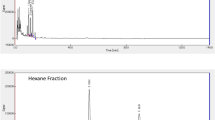A phytocomposition of soy lecithin, glycyrrhizic acid, lycopene, and ecdysterone (conventional name Hepalipin) significantly prevents the development of cytolytic-cholestatic liver damage, contributes to the maintenance of protein- and glycogen-synthesizing functions of the liver, reduces its fatty degeneration, restrains disorders of pigment metabolism, and exhibits an antioxidant effect when administered to experimental animals against the background of developing chronic toxic hepatitis caused by carbon tetrachloride. Hepalipin improves disturbed bile chemical composition and secretion. The continued administration of Hepalipin to rats for another two weeks after the cessation of carbon tetrachloride injections leads to almost complete restoration of all studied parameters to their initial (intact) values. Hepalipin under conditions of experimental chronic hepatitis showed statistically significant advantages compared to Phosphogliv in terms of the intensity of the hepatoprotective effect.
Similar content being viewed by others
References
O. N. Minushkin, Gastroenterologiya, No. 1 – 2, 2 – 8 (2005).
S. V. Moiseev, Klin. Farmakol. Ter., No. 1 – 2, 10 – 14 (2005).
G. G. Onishchenko, Med. Kur’er, No. 1 – 2, 13 – 15 (2002).
S. D. Podymova, Liver Diseases [in Russian], Meditsina, Moscow (1993).
S. Sherlock and J. Dooley, Diseases of the Liver and Biliary System, 10th Ed., Blackwell Science, Oxford (1997) [Russian translation, GEOTAR-Media, Moscow (1999)].
M. D. Mashkovskii, Drugs [in Russian], RIA Novaya Volna, Moscow (2008), pp. 526 – 529.
I. A. Vasilenko, G. V. Dolgova, G. M. Sorokoumova, et al., Russ. Med. Zh., 18(6), 352 – 355 (2010).
V. F. Uchaikin, V. I. Luchshev, S. N. Zharov, et al., Klin. Med., No. 5, 39 – 42 (2000).
U. Y. Yusupova, N. Sh. Ramazonov, V. N. Syrov, and Sh. Sh. Sagdullaev, Phytoecdysteroids (Properties, Biological Activity and Applications), Springer, Singapore (2002); doi: 10.1007 / 978-981-16-6711-4.
Sh. Sh. Sagdullaev, N. V. Tursunova, S. D. Gusakova, et al., RUz Pat. UZ IAP 05701; Byull., No. 12 (2018).
M. Kates, Techniques of Lipidology: Isolation, Analysis, and Identification of Lipids, Elsevier, New York (1972), 610 pp.
N. Kh. Abdullaev, Pathochemistry and Pathogenetic Therapy of Chronic Hepatitis and Liver Cirrhosis [in Russian], Meditsina, Tashkent (1968).
V. S. Kamyshnikov, Handbook of Clinical and Biochemical Research and Laboratory Diagnostics [in Russian], Medpress-Inform, Moscow (2009).
S. Lo, J. C. Russel, and A. W. Taylor, J. Appl. Physiol., 28(2), 234 – 236 (1970).
B. P. Neri and C. S. Frings, Clin. Chem., 19(10), 1201 – 1202 (1973).
I. D. Stal’naya and T. G. Garishvili, in: Modern Methods in Biochemistry [in Russian], V. I. Orekhovich (ed.), Meditsina, Moscow (1977), pp. 66 – 68.
M. A. Korolyuk, L. I. Ivanova, I. G. Maiorova, and V. E. Tokarev, Lab. Delo, No. 1, 16 – 19 (1988).
E. E. Dubinina, L. A. Sal’nikova, and L. F. Efimova, Lab. Delo, No. 10, 30 – 33 (1983).
Ya. I. Karbach, Biokhimiya, 26(2), 305 – 309 (1961).
S. M. Drogovoz, Vopr. Med. Khim., No. 4, 397 – 400 (1971).
N. P. Skakun, Probl. Endokrinol., No. 6, 75 – 78 (1956).
V. N. Syrov, Eksp. Klin. Farmakol., No. 5, 61 – 65 (1994).
V. N. Syrov, Farm. Byull. (Karaganda), No. 3 – 4, 111 – 117 (2015).
M. X. Nguyen and S. J. Schwarts, Food Technol. (Chicago), 53, 38 – 45 (1999).
Author information
Authors and Affiliations
Corresponding author
Additional information
Translated from Khimiko-Farmatsevticheskii Zhurnal, Vol. 56, No. 11, pp.3– 8, November, 2022.
Rights and permissions
Springer Nature or its licensor (e.g. a society or other partner) holds exclusive rights to this article under a publishing agreement with the author(s) or other rightsholder(s); author self-archiving of the accepted manuscript version of this article is solely governed by the terms of such publishing agreement and applicable law.
About this article
Cite this article
Syrov, V.N., Gusakova, S.D., Khushbaktova, Z.A. et al. Hepatoprotective Efficacy of a New Phytocomposition of Essential Phospholipids with Glycyrrhizic Acid, Ecdysterone, and Lycopene in Experimental Chronic Hepatitis Compared to Phosphogliv. Pharm Chem J 56, 1433–1438 (2023). https://doi.org/10.1007/s11094-023-02811-6
Received:
Published:
Issue Date:
DOI: https://doi.org/10.1007/s11094-023-02811-6



